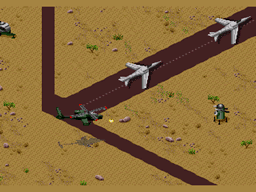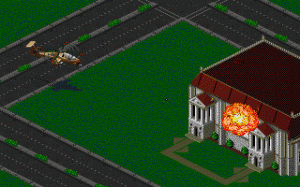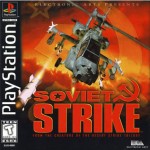As times change and the focus of video games shifts to reflect the latest trends and technology, one thing remains an industry constant: people love to blow things up. Give them some firepower and stand back, and the bigger the gun, the better. The best way to wreak mass destruction is with some sort of military vehicle, and what better choice is there than an Apache helicopter?
The entire premise of Electronic Arts’ Strike series revolves around this singular reality. Make no mistake; you might save a hostage here and there, but this is a franchise devoted to unleashing as much “shock and awe” as possible. There’s little else in gaming that’s as satisfying as seeing the bad guy go up in a cloud of fire and debris (hmm, sounds like I have issues!) and this is perhaps one of the funniest ways to go about it. The Strike games have allowed players to take out dictators, drug lords, and terrorists with extreme prejudice, offering the best the U.S. military has at its disposal to, well…dispose of those out to make the world unsafe.
Developer History
 The father of the Strike games is Mike Posehn, an engineer, software developer, and talented digital photographer with nearly three decades experience in the gaming industry and a lifetime of computer knowledge. He possesses a Ph.D in mechanical engineering, as well as a M.S. in electrical engineering and computer science, and was one of the first fifty people to join Electronic Arts when his first company was bought out in 1984. A year earlier, he had established a new development company, Granite Bay Software, which produces time-lapse and digital photography software for PCs. and continues to run it today. In his spare time, Posehn is an avid photographer and sportsman.
The father of the Strike games is Mike Posehn, an engineer, software developer, and talented digital photographer with nearly three decades experience in the gaming industry and a lifetime of computer knowledge. He possesses a Ph.D in mechanical engineering, as well as a M.S. in electrical engineering and computer science, and was one of the first fifty people to join Electronic Arts when his first company was bought out in 1984. A year earlier, he had established a new development company, Granite Bay Software, which produces time-lapse and digital photography software for PCs. and continues to run it today. In his spare time, Posehn is an avid photographer and sportsman.
The Games
The Strike games have their origin in another famous helicopter shooter, Sega’s Choplifter. EA president Trip Hawkins approached Posehn and asked him to come up with something similar. Not wanting to directly emulate the competition, Posehn came with the unique idea of the helicopter control sharing the best two viewpoints. “It was a third-person view with first-person controls,” he commented when we spoke to him in 2005, and that’s about as good a summary as any. The perspective was unique, and the gameplay was less arcadey than the visuals suggested, and this combination of factors hooked gamers from the start.
Arriving in 1992, with America’s victory in Kuwait still a fresh topic on the lips of the media, the original eight meg Desert Strike had the player assume the role of an
AH-64 Apache pilot out to stop the evil General Kilbaba (Muababa in the Game Boy Advance version) from launching a nuclear attack on the west in revenge for the Gulf War defeat. Twenty-seven tough (very tough) combat missions, each divided over four campaigns and with multiple military objectives, guided you through the process of systematically destroying the dictator’s capacity for war. Rescue POWs, eliminate energy grids and intelligence centers, knock out early warning systems, and defending friendly territory were all tasks that seem insurmountable to the newcomer. See, you helicopter not only had a limited amount of weapons, fuel, and armor; but you also had severely limited chances to replenish them. Charging into a hail of SCUD missiles was suicide, so strategy played an important role. There was no real order to the missions, and you could tackle them however you wanted, but it was much easier to destroy an airfield after eliminating the enemy’s radar. This was no straight-up shooter, and reckless and foolhardy pilots saw the “Game Over” screen more than anything else. Thankfully, a password system was included, so you never had to worry about starting over each time.
While its from-behind view gave the impression that Desert Strike’s gameplay was arcade-like, the truth was quite the opposite. Unlike Choplifter, the Apache used here actually made an attempt to mimic the actual flight dynamics of a helicopter. You couldn’t stop and turn on a dime (momentum was a factor), and there was an actual range of distance you could fly on a single tank of fuel. This made for some tense moments, especially when your smoking chopper, full of rescued POWs, was one hit away from destruction, its guns empty, and that fuel light blinking menacingly at you. Making it over those sand dunes and down to the U.S. amphibious craft on the beach was indeed a welcome sight! Your copilot, one of whom you had to rescue, played a major role in your missions. The higher his rating, the better he was at manning the winch (needed for picking up supplies and passengers). You were in control of the weaponry, however, which is what we all wanted anyway. For an even more enhanced experience, the game could be played with any of the Genesis flight sticks that were available, such as the Quickshot Python 3 or the mighty Quickshot Flight Stick.
Desert Strike was a massive success and quickly saw ports to several other platforms, including the Amiga and PC. Not content to rest on its laurels, Electronic Arts released the sequel, Jungle Strike, a year later. The story picks up where the first left off, with Kilbaba’s son Ibn filled with rage at his father’s defeat and seeking revenge against the U.S. (seriously, the Kilbaba family is in dire need of therapy). After he is tossed out of his homeland, he teams up with Carlos Ortega, latin cliche and the world’s most dangerous druglord, to recapture his country and destroy his enemies.
This wasn’t simply the same game with better visuals, and Posehn’s team tweaked and improved the gameplay on several levels, also doubling the memory size to a (then) big sixteen megs. Additionally, they added new vehicles to accompany the famous helicopter (this time an RAH-66 Comanche, instead of an Apache). Available were the MX-9 attack hovercraft, special forces assault motorcycle, and even a stolen F-117 Stealth Fighter! The ability to change vehicles added another level of challenge and strategy by compelling the player to decide when it was best to change. Some missions could be carried out by two or more craft, so it wasn’t necessarily mandatory to switch. This freedom allowed for some great experimentation, and it was interesting to push a particular choice to the limit of endurance, armament, and function.
Also enhanced were the functions of the indispensable copilot. He was no longer solely in charge of the winch, and his abilities now encompassed the craft’s armament as well. This played the same as in Desert Strike, and only the effectiveness of firing changed depending on which copilot you had. Among the crewman’s new skills were range-aim (the distance he could effectively aim at a target) and rate of fire.
 Jungle Strike was very well received, and brisk sales of the emerging franchise guaranteed another sequel would be made. The next game, called Urban Strike, exploded onto the Genesis and SNES in 1994, boasting yet more upgrades and refinements. This time, the action took place right at home in America, and the the newly formed Strike C.O.R.E. team faced a evil media mogul named H.R. Malone who was out to overthrow the government. Using a whole new selection of military weaponry (some of it still experimental), the team sets out to defend the U.S. Ironically, Urban Strike featured a prediction of an attack on the World Trade Center in the year 2001, only by a different method.
Jungle Strike was very well received, and brisk sales of the emerging franchise guaranteed another sequel would be made. The next game, called Urban Strike, exploded onto the Genesis and SNES in 1994, boasting yet more upgrades and refinements. This time, the action took place right at home in America, and the the newly formed Strike C.O.R.E. team faced a evil media mogul named H.R. Malone who was out to overthrow the government. Using a whole new selection of military weaponry (some of it still experimental), the team sets out to defend the U.S. Ironically, Urban Strike featured a prediction of an attack on the World Trade Center in the year 2001, only by a different method.
The theme of changing vehicles was further explored here, and you now had a choice of two helicopters, the Blackhawke and the experimental Mohican, and the ground assault vehicle (GAV). New to the series was the ability to set out on foot inside of buildings. Most of the missions of this type were timed, and retained the series’ famed difficulty. The levels were added at EA’s insistence, as Posehn has stated that he never liked the idea of the player getting out of the helicopter and would have instead preferred to increase the craft’s weaponry. Over forty missions in ten levels made this the largest Strike game yet. It would also be the last on the Genesis.
As the 32-bit generation loomed, Electronic Arts moved the series to the new hardware, taking advantage of all the bells and whistles the CD medium had to offer. Appearing on both the Saturn and the Playstation in 1996, EA seemingly paid homage to the company that gave the franchise its start by including extra weapons for the Saturn version. Aside from this slight change, the differences between the two are mostly cosmetic.
Set after Desert Strike and the collapse of the Soviet Union, Soviet Strike sees a former KGB general known only as “Shadowman” has taken control of the former super power’s nuclear arsenal with blinding speed. You’ve gone from being a loner to a member of an elite force, and now you answer to the Global Strike Force. Apparently, anti-terrorist teams were in demand long before 9/11. Did EA know something we didn’t?
The basic gameplay is still the same, and aside from the improvements to the presentation and straight-out-of-the-news geographical locations, the developers also added what they called the “living battlefield.” That is to say, enemies no longer waited for you to come close before they acted. Each had its own objective and would carry it out regardless of where you were. Now, you could be attacking a convoy to the south, and be informed that a group of tanks was attacking your HQ in the east, forcing you to high tail it back to base. Fail to arrive in time, and all you got was a SNAFU (Situation Normal All Fucked Up) for your troubles.
While it showed that the classic Strike gameplay was as solid as ever in the new age of consoles, Soviet Strike on the Saturn had one defining characteristic: it played like a dream with the Saturn Mission Stick. Some might have preferred the cleaner 3D graphics of the Playstation version, but there was just no equal to the Saturn’s wonderful Flight Stick. It could be adapted for right or left handed playing, and there was just a greater feel of actually flying a helicopter. Add the bonus goodies EA tossed in and you had the definitive package.
Mike Posehn is credited only as having provided “original software design.” It is unknown why he had a diminished role in this installment, but it could most likely be attributed to a desire to move on to new projects. Electronic Arts went ahead and released Nuclear Strike on the PlayStation in 1997. Sadly, this would be the first game without Posehn’s input. Many members of the team remained, and while Nuclear Strike was often overlooked by gamers, it was a solid title in its own right.
It’s a good thing that it played well, since the story alone wasn’t be enough to carry it. Once again, a madman was threatening to unleash nuclear devastation upon the world, and your crack team was the only group able to stop him. By now, the plot was becoming pretty long in the tooth, but the action was thankfully enough to keep you playing. Five vehicles were at your disposal this time around, including three helicopters (Comanche, Super Apache, and a Huey), the hovercraft, and a Harrier jet. The HUD (Heads Up Display) was improved to allow easier navigation, which meant you spent less time looking at the map to determine where to go next.
Like the previous game, Nuclear Strike kept the action close to real life hotspots in southeast Asia, including the DMZ in Korea. The visuals had been further enhanced, built from the ground up for the Playstation’s light sourcing and shading effects. It sold well enough to be rereleased as part of Sony’s Greatest Hits lineup but received a relatively lukewarm reception from the press. No one knows exactly why, but Nuclear Strike would be the final game in the series.
Strike Out?
 At the end of Nuclear Strike, a video spot for the next game is shown. Titled Future Strike, this newest entry was already well under way at Electronic Arts but mysteriously disappeared for some unknown reason. Some have speculated that it evolved into Future Cop: LAPD, as that game featured the same style of gameplay. This has never been corroborated, and to this day no one knows exactly what became of Future Strike.
At the end of Nuclear Strike, a video spot for the next game is shown. Titled Future Strike, this newest entry was already well under way at Electronic Arts but mysteriously disappeared for some unknown reason. Some have speculated that it evolved into Future Cop: LAPD, as that game featured the same style of gameplay. This has never been corroborated, and to this day no one knows exactly what became of Future Strike.
In this day and age of retro series making comebacks on all platforms, one would think that the time would be ripe for Electronic Arts to revive this franchise, especially when it’s sold over four million units in all. Modern handhelds are more than capable of supporting a new entry in 3D or even a remake. Hopefully, someone at the company will realize that there are still fans eagerly awaiting more Strike games. Until that day comes, we have five great titles to enjoy. Like I said, blowing things up never gets old.
The complete release chronology is as follows:
- Desert Strike, Genesis (1992)
- Desert Strike, SNES (1992)
- Desert Strike, Master System (1992)
- Desert Strike, Amiga (1993)
- Desert Strike, Atari Lynx (1993)
- Jungle Strike, Genesis (1993)
- Jungle Strike, SNES (1993)
- Desert Strike, Game Gear (1994)
- Desert Strike, DOS-PC (1994)
- Jungle Strike, Amiga (1994)
- Jungle Strike, Amiga CD32 (1994)
- Urban Strike, Genesis (1994)
- Urban Strike, SNES (1994)
- Urban Strike, Game Gear (1994)
- Desert Strike, Game Boy (1995)
- Desert Strike/Jungle Strike, DOS-PC [compilation] (1995)
- Jungle Strike, DOS-PC (1995)
- Jungle Strike, Game Gear (1995)
- Jungle Strike, Game Boy (1995)
- Urban Strike, Game Boy (1996)
- Soviet Strike, Sega Saturn (1996)
- Soviet Strike, Playstation (1996)
- Nuclear Strike, Playstation (1997)
- Nuclear Strike, Windows PC (1997)
- Nuclear Strike, N64 (1999)
- Desert Strike, Game Boy Advance (2002)
- Desert Strike, Sony PSP [EA Replay compilation] (2006)
- Jungle Strike, Sony PSP [EA Replay compilation] (2006)
Sources
- Game Information: EA Replay. Electronic Arts. 2006
- Posehn, Mike. Biographical data. Dog’s Leap. 2006.
- —. Interview with Ken Horowitz. Sega-16. January 27, 2005.
- Press Release. Electronic Arts Ships Nuclear Strike for the PlayStation. Business Wire. Sept. 24, 1997.

Recent Comments